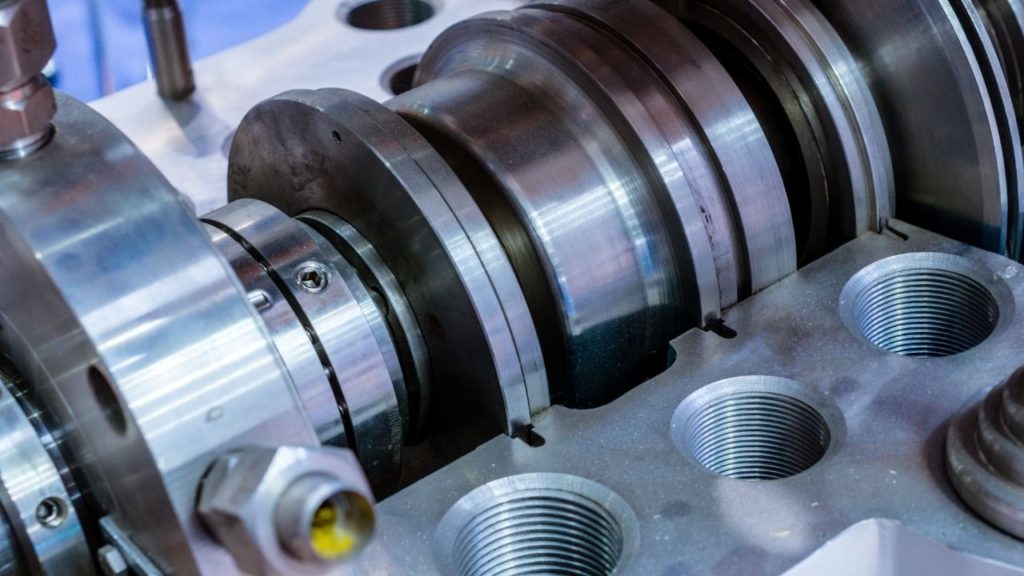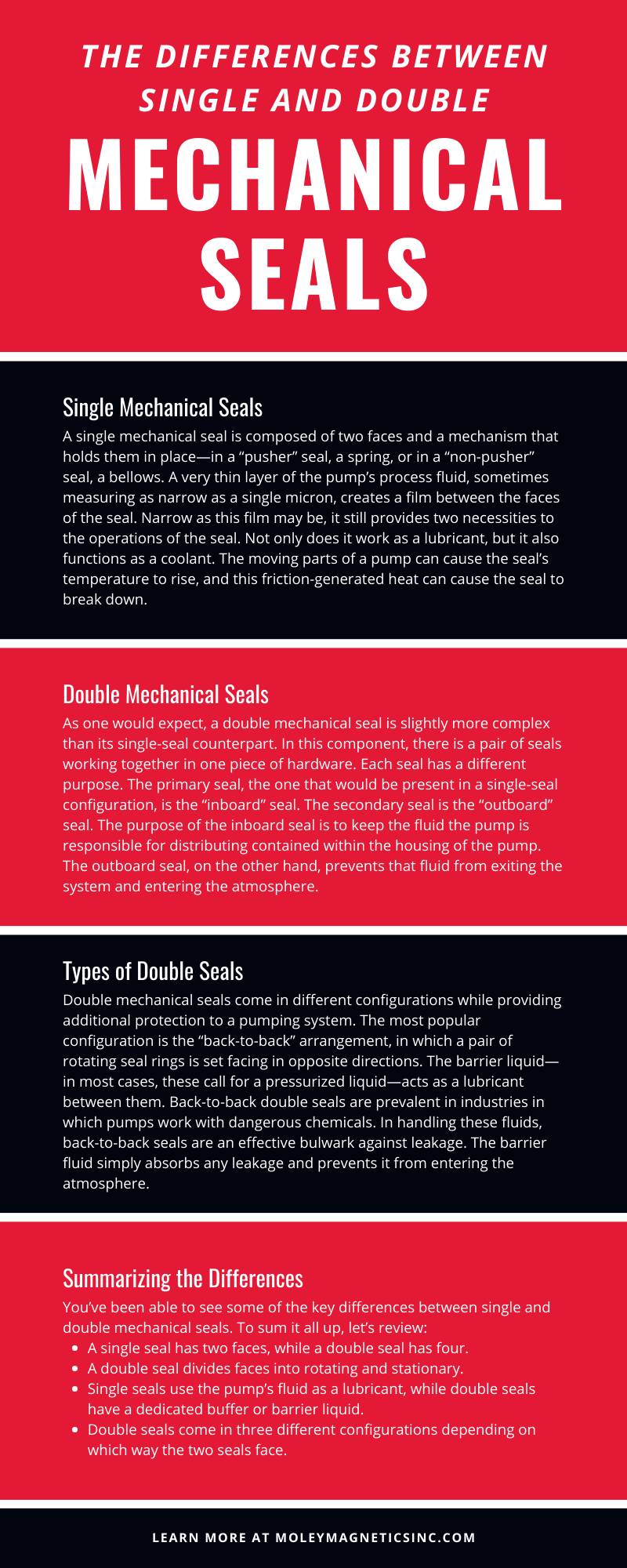
The Differences Between Single and Double Mechanical Seals
Pumps work hard to distribute fluid throughout elaborate systems. As a failsafe against leakage, pumps include one of two parts: packings or mechanical seals. While packing is a simple and inexpensive way to prevent fluids from leaking through their pumps, the packing material requires near-constant maintenance. Operators must keep packing lubricated, properly aligned, and sufficiently cool in order to keep a pump working smoothly. For this reason, more and more mechanical engineers are turning to mechanical seals to contain fluids that circulate through pumps.
A mechanical seal works by connecting to a pump’s rotating shaft and prevents the fluid a pump circulates from leaking around the impeller, which could damage the operations of the pump or process piping, as well as waste a precious fluid. At the same time, a mechanical seal also protects the fluid in question from adulterants or outside particles. For instance, dust or grit could inadvertently make its way into a delicate fluid, making it unacceptably abrasive.
Mechanical seals can be divided along several lines. In a previous entry, we examined how there are either balanced or unbalanced models, either spring-loaded seals or equipped with a bellows. There’s another angle to seal taxonomy—single versus double seals. While the initial impulse would be to believe a double seal is simply twice as effective, there’s more than meets the eye here. Ahead, we’ll go over some of the key differences between single and double mechanical seals. Allow us to compare and contrast these two approaches to mechanical seals for pumps and determine which model is right for your system and processes.
Single Mechanical Seals
A single mechanical seal is composed of two faces and a mechanism that holds them in place—in a “pusher” seal, a spring, or in a “non-pusher” seal, a bellows. A very thin layer of the pump’s process fluid, sometimes measuring as narrow as a single micron, creates a film between the faces of the seal. Narrow as this film may be, it still provides two necessities to the operations of the seal. Not only does it work as a lubricant, but it also functions as a coolant. The moving parts of a pump can cause the seal’s temperature to rise, and this friction-generated heat can cause the seal to break down. Unlike packing, where a pumping system can function while it undergoes repairs, a system that relies on a mechanical seal necessitates a full shutdown in order to perform repairs. This makes minimizing such interventions imperative for engineers and operators.
Double Mechanical Seals
As one would expect, a double mechanical seal is slightly more complex than its single-seal counterpart. In this component, there is a pair of seals working together in one piece of hardware. Each seal has a different purpose. The primary seal, the one that would be present in a single-seal configuration, is the “inboard” seal. The secondary seal is the “outboard” seal. The purpose of the inboard seal is to keep the fluid the pump is responsible for distributing contained within the housing of the pump. The outboard seal, on the other hand, prevents that fluid from exiting the system and entering the atmosphere.
Between them is a lubricant that goes by one of two names depending on its level of pressurization. When this lubricant is at a lower pressure than that of the pump’s fluid, we know it as a buffer liquid. A pressurized lubricant that separates the pump’s fluid from the atmosphere, however, is referred to as a barrier liquid. Popular buffer and barrier fluids include alcohol, propylene glycol, and petroleum products such as kerosene and diesel, though applications in which flammability is a concern necessarily contraindicate using any petroleum derivatives. In situations where boiling or freezing temperatures are not a concern, sometimes simple distilled water can serve as an ideal buffer or barrier liquid.
Just as a single seal has two faces, a double seal has four. Here, two faces are in rotation, while the other two remain stationary. This prolongs the life of the seal by concentrating wear upon the stationary faces while the rotating faces take less damage.
Types of Double Seals
Double mechanical seals come in different configurations while providing additional protection to a pumping system. The most popular configuration is the “back-to-back” arrangement, in which a pair of rotating seal rings is set facing in opposite directions. The barrier liquid—in most cases, these call for a pressurized liquid—acts as a lubricant between them. Back-to-back double seals are prevalent in industries in which pumps work with dangerous chemicals. In handling these fluids, back-to-back seals are an effective bulwark against leakage. The barrier fluid simply absorbs any leakage and prevents it from entering the atmosphere. Less prevalent now is the “face-to-face” arrangement, which uses two pusher seals facing toward each other. This is still a popular choice in the food-processing industry, but is not popular when working with more hazardous media. The third common configuration is face-to-back, or “tandem.” A tandem arrangement allows for high volume and high pressure of the barrier liquid, while its outboard seal is a particularly valuable failsafe against pressure buildup, which prevents loss of the fluid in question to the atmosphere. Though a reliable design, the associated expenses of developing and maintaining a tandem seal have made the back-to-back configuration more popular in most respects.
Summarizing the Differences
You’ve been able to see some of the key differences between single and double mechanical seals. To sum it all up, let’s review:
- A single seal has two faces, while a double seal has four.
- A double seal divides faces into rotating and stationary.
- Single seals use the pump’s fluid as a lubricant, while double seals have a dedicated buffer or barrier liquid.
- Double seals come in three different configurations depending on which way the two seals face.
Where To Find Them
If your industrial processes could benefit from the added safety and performance of double mechanical seals over their simpler single siblings, Moley Magnetics has you covered with an extensive selection of industrial mechanical seals for your facility. Moley now partners with John Crane, the industry leader in pump seals, to provide smooth operations for our customers across diverse industries.


